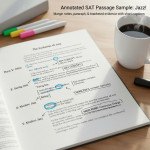Single‑AP Pilot Year: What It Is and Why Families Are Talking About It
Imagine a school year where a motivated student takes just one AP course and exam — deeply focused, less scattered, and designed as a proof‑of‑concept to test whether concentration beats overload. That’s the idea behind a Single‑AP pilot year: a deliberate, school‑ or district‑led experiment that lets students—and their families—see what sustained, concentrated AP study feels like and what outcomes it produces.
This model isn’t about limiting ambition. It’s about trying something strategic: fewer subjects, more depth, better habits, and a clearer measure of both learning and college readiness. For families who are juggling course loads, extracurriculars, and wellbeing, a Single‑AP pilot can be an attractive alternative to the “take as many as you can” mentality.

Why Run a Pilot Year?
Pilots are how schools test new approaches without committing to wholesale change. The Single‑AP pilot year lets administrators, teachers, students, and families collect data on outcomes that matter: exam scores, retention of knowledge, stress levels, attendance, and college counselor feedback. It’s a low‑risk way to answer practical questions: Do students who focus on one AP learn more deeply? Are they more likely to retain and use that knowledge in college coursework? How does one‑course focus affect mental health and extracurricular engagement?
Who Benefits From a Single‑AP Year?
This model isn’t one‑size‑fits‑all. But it has clear appeal for several groups:
- First‑time AP students: Students new to AP rigor who want to learn how college‑level classes feel without overwhelming themselves.
- Students balancing heavy outside commitments: Athletes, musicians, caretakers, or students with demanding jobs who need to be selective.
- Families prioritizing wellbeing: Parents who want to avoid burnout or who value concentrated mastery over a long list of AP titles.
- Students exploring future majors: If your child suspects they’ll major in a field best tested by one AP (e.g., AP Biology for pre‑med interests), a focused year can be illuminating.
How Schools Might Structure a Pilot
A well‑designed pilot includes clear goals, data collection, and supports for participating students. Typical elements include:
- Selection criteria and an opt‑in process for students and families.
- Defined metrics: exam participation rate, average scores, AP Classroom usage, wellness surveys.
- Teacher professional development and alignment with AP resources.
- Additional supports like tutoring, extended office hours, and parent briefings.
What Families Should Ask Before Opting In
If your school offers a Single‑AP pilot, you’ll want to make an informed choice. Here are practical questions to ask counselors and teachers:
- What are the objectives of the pilot? Academic gains, reduced stress, or improved access?
- How will success be measured and reported to families?
- What additional supports are available (review sessions, tutoring, AP Classroom)?
- Is the AP exam required at the end of the year or optional?
- How does participation affect GPA weighting and college reporting?
- Can a student add other honors or dual‑enrollment courses alongside the Single‑AP?
Realistic Scenarios: Two Family Stories
Stories help turn abstract policy into decisions you can relate to. Consider these two fictional but realistic scenarios:
- Emma, a First‑Year AP Student: Emma is curious about taking AP Psychology but is also playing varsity soccer. The Single‑AP approach lets her commit to AP Psych, join a weekly review group, and use targeted tutoring for test‑taking strategies. She learns how to pace herself and ends the year confident about both the score and her schedule.
- Raj, a Prospective STEM Major: Raj has strong math and science interests but also a part‑time research internship. He chooses a single AP (AP Calculus BC) to ensure he masters foundational concepts before college. His family invests in 1‑on‑1 guidance that includes tailored problem sets and pacing tools — a setup that maximizes learning without sacrificing his internship.
Planning for Success: A Family Checklist
Opting into a Single‑AP pilot is not a passive decision. Approach it like a project, with planning and checkpoints. Here’s a family checklist to guide the year:
- Choose the AP that matches interest and potential college relevance.
- Map the school calendar: major assessments, AP registration deadlines, and college application season.
- Set weekly study goals and a realistic daily schedule.
- Identify support structures: teacher office hours, peer study groups, and tutoring.
- Track wellbeing: sleep, exercise, and stress check‑ins every month.
How Tutoring Fits Naturally
One of the biggest benefits of a Single‑AP pilot is the opportunity for highly targeted support. Personalized tutoring — whether through school programs or services like Sparkl’s personalized tutoring — can be transformational. With focused one‑on‑one guidance, students get tailored study plans, expert tutors who know the AP rubric, and AI‑driven insights that spot gaps early. Instead of a generic “review,” students receive strategic help: pacing, practice exams, feedback on free‑response questions, and stress‑management techniques specific to AP pacing.
Designing a Study Plan: Week‑by‑Week to Exam Day
A good plan converts the year into manageable milestones. Below is a sample high‑level timeline for an AP year (assuming a May exam):
| Timeframe | Focus | Key Actions |
|---|---|---|
| August–October | Foundations | Build core knowledge, begin AP Classroom topic work, weekly tutoring check‑ins. |
| November–January | Application | Increase problem complexity, start timed practice sections, address weak topics. |
| February–March | Consolidation | Full practice exams monthly, targeted feedback loops, refine essay/free‑response skills. |
| April–Early May | Final Prep | Practice tests under exam conditions, review sheets, exam logistics, wellness plan. |
| Exam Day | Performance | Rest the night before, light review in the morning, arrive early and calm. |
Weekly Micro Plan (Example)
- Monday: New topic introduction with class notes review (30–45 minutes).
- Wednesday: Problem practice and targeted tutoring session (60 minutes).
- Friday: Quick quiz or self‑check and AP Daily video review (30 minutes).
- Weekend: Longer practice set or free‑response practice (60–120 minutes).
What Families Should Watch For: Risks and Mitigations
No pilot is perfect. Awareness of potential pitfalls lets you steer around them:
- Overconfidence: Focusing on one subject can create a false sense of security. Mitigation: regular low‑stakes assessments and third‑party practice exams.
- Equity concerns: Students with access to private tutoring may benefit more. Mitigation: schools should offer in‑school supports and scholarships for extra help.
- GPA or transcript implications: Families should confirm how the AP will be recorded and weighed.
- College perceptions: Admissions generally care about course rigor in context — a Single‑AP year that demonstrates depth and strong outcomes can be compelling when explained on applications.
How to Talk About a Single‑AP Year in College Applications
Admissions officers read context. If a student chooses a Single‑AP year thoughtfully, the application narrative should explain why: a strategic choice to deepen knowledge, balance other commitments, or pursue a meaningful internship. Include: what you learned, how you grew, and how the experience prepared you for the major or college experience you seek.
Measuring Success: What Data Matters
Pilots should track multiple metrics beyond raw AP scores. Consider these measures:
- AP exam participation and pass rates (scores of 3+ or as defined by colleges).
- Growth on formative assessments and AP Classroom progress checks.
- Student wellbeing metrics: self‑reported stress, sleep, and engagement.
- College counselor feedback and early college placement results when available.
Sample Data Table: Hypothetical Pilot Results
The following table is an illustrative example of the types of data a school might collect from a pilot cohort of 60 students. (This is hypothetical and intended to show how results could be summarized.)
| Metric | Before Pilot | After Single‑AP Year | Change |
|---|---|---|---|
| Average AP Score (on 1–5) | 3.1 | 3.6 | +0.5 |
| Students Reporting High Stress | 46% | 28% | −18% |
| Exam Participation Rate | 82% | 95% | +13% |
| Students Using Tutoring | 31% | 62% | +31% |
Practical Tips for Day‑to‑Day Success
Beyond big plans, small habits make a huge difference. Help your student adopt routines that support sustained learning:
- Use short, focused study windows (25–50 minutes) and a brief break (5–10 minutes).
- Keep a single dedicated AP notebook for notes, practice, and teacher feedback.
- Regularly practice pacing for multiple‑choice sections and timed free‑response writing.
- Record mistakes and revisit them weekly — patterns reveal priorities.
- Balance caffeine and sleep; cognitive performance declines much faster than most teens realize.
When to Bring in Extra Help
If your student consistently struggles with foundational concepts, misses practice deadlines, or shows growing anxiety about the exam, it’s time for extra support. That’s where personalized tutoring can deliver a big return on investment: targeted sessions to shore up weak spots, practice under realistic conditions, and coaching on exam strategies and stress management. Sparkl’s tutoring model, for example, pairs students with expert tutors, creates tailored study plans, and uses AI‑driven insights to pinpoint gaps — perfect for families who opt into a Single‑AP year and want efficient, effective support.
Evaluating the Pilot at Year’s End
After exam day, the pilot evaluation phase begins. Schools should summarize results, solicit student and parent feedback, and share recommendations. Families should ask for a clear report that includes both quantitative outcomes (scores, participation) and qualitative reflections (student experience, teacher observations).
What Constitutes a Successful Pilot?
Success can look different depending on goals, but a thoughtful pilot will usually show:
- Improved or stable AP outcomes with reduced stress indicators.
- High participation in exam day and support services.
- Clear student narratives about learning and readiness for next steps.
- Actionable recommendations for scaling, modifying, or discontinuing the pilot.
Final Thoughts: Is Single‑AP Right for Your Family?
Deciding to participate in a Single‑AP pilot year is both strategic and personal. It’s not a compromise; it’s a choice to focus. For many students, one intentionally chosen AP course can lead to deeper learning, better wellbeing, and stronger college readiness signals — especially when combined with supports like in‑school tutoring, AP Classroom resources, and personalized 1‑on‑1 guidance from expert tutors.
Keep these guiding principles in mind when considering a Single‑AP year:
- Fit the AP to the student’s interests and academic goals.
- Treat the year as an experiment: set measurable goals and collect evidence.
- Invest in targeted supports early — they pay off more than last‑minute cramming.
- Use the pilot to learn about study habits and college preparedness, not just a single score.

Need a Practical Next Step?
If your school offers a Single‑AP pilot, sit down with your student and the AP teacher to map a plan that includes weekly milestones, practice exams, and a support network. If extra help makes sense, look for tutors who can align their work to the AP rubric and provide tailored pacing — whether that’s through school programs or a service that offers one‑on‑one guidance and AI‑driven study plans.
Closing: The Power of Focus
The Single‑AP pilot year isn’t about minimizing ambition — it’s about amplifying impact. For many families, the proof‑of‑concept is simple: fewer simultaneous commitments can produce stronger learning, better mental health, and clearer evidence for what works. Whether you’re cautious about overload or curious about a concentrated approach, a Single‑AP year can offer clarity. And with thoughtful planning and targeted supports, students can emerge not only with a solid AP score but also with deeper confidence and readiness for whatever comes next.
Remember: education is not just about the number of boxes checked on a transcript. It’s about the quality of learning, resilience, and the habits you build. A Single‑AP pilot year gives families a controlled, meaningful space to try a different path — one that might just set students up for long‑term success.




















No Comments
Leave a comment Cancel